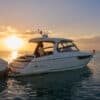If you’re a new boater looking for a guide for boating laws and regulations, you’re in the right spot.
Boating is a lifestyle loved and enjoyed by many families throughout the world. Whether you’re boating on an inland lake, reservoir, the ocean, or any other waterway, it’s a great way to enjoy time on the water. While it is a fun activity, it’s important to understand and learn all about boating laws and regulations.
Boating laws and regulations have been put into place to keep all boaters safe while enjoying time on the water. Following these laws will help to ensure safety while on the boat. Keep reading to learn more about safety guidelines for boating.
Required Gear
Though there are several standard boating laws, many laws vary between states and waterways. This is because no two waterways require the exact same laws and regulations that are specific to that waterway.
Federally enforced boating laws include the equipment required on board. Here’s a list of the required equipment regardless of where you’re boating:
- Life Jackets
- Throwable Device
- Fire Extinguisher
- Visual Distress Signal
- Sound Producing Device
- Ventilation System
- Backfire Flame Arrestor
These items and systems are required on all boats of 16 feet and over. As you move into larger boats, always check that there aren’t additional requirements. Making sure you have the correct safety gear on board will help to keep you and everyone else safe.
Boating Laws
Boating laws are enforced by several law enforcement agencies across the country. From the DNR to local police to the Coast Guard. These agencies help to keep everyone on the water safe and having a good time.
Like the boating gear requirements, boating laws vary throughout different states and areas as well. Some states require a skier down flag whereas others don’t. With different waterways and boaters, be sure to double-check state boating laws.
It’s also important to note that local waterways have additional laws outside of the state and federal laws. Therefore, my advice is to research your local waterway before launching your boat.
License and Registration
Along with following boaters’ safety laws and regulations, another step must be taken to ensure you’re not breaking any laws. Your boat must be registered with the state. This is true for any boats that are powered.
Regardless of whether your boat only has a trolling motor or a 400 HP outboard, it requires registration with the state. Registration is shown by numbers given by the state, similar to a license plate.
As for a license, different states have different laws for boater’s license regulations. Some states require a boater’s license to drive all boats, others only require them to drive a PWC. Some states require licenses based on age. Before heading on the water, be sure to research the requirements of your state.
Driving Safety
Now that you are legally ready to take off into the water, there are several other guidelines to know. First on the list is driving your boat.
The laws of the water are different than those on the road. Knowing different signals and signs is crucial to the safety of everyone on board.
Before heading on the water, know this information:
- How to safely navigate waterways
- Who has the right of the way
- Nautical terms and how they relate to real-life situations
- Know where hazards are
Knowing how to handle several situations on the water will help to keep everyone on the water safe. Some scenarios that may challenge your skills include towing a tuber or skier and protecting swimmers around boats.
Towing
There’s a lot of responsibility involved with towing people for water sports. From taking off to picking up a rider and navigating other boats in between, there is risk involved.
When taking off, make sure the rider is ready to go. You’ll want to base the take-off speed on the sport. Different sports and skill levels require different take off speeds. Communicate with the rider to ensure you’re both on the same page.
Once the rider is up, as the driver, you’ll need to navigate the water safely to keep everyone on board and behind the boat safe. Whether that be other boats, hazards, or other factors, proper navigation is key.
One of the most difficult parts of driving a boat for water sports is to pick up the rider after they have fallen. When they drop, slow the boat to neutral then begin to turn around. Do not try to power turn as it will make picking up the fallen rider even more difficult. Slowly approach the rider on the driver’s side of the boat. This way the rider is always within your vision.
Swimmers
Driving a boat around while there are swimmers poses another challenge. Most of the time, swimmers will stay very close to their boat. However, some swimmers venture further from their boat.
A good rule of thumb to follow is whenever you see swimmers in the water, give that boat more than enough space. Keep your eyes open and make sure you’re always giving other boats plenty of space.
Your Guide to Boating
Following the rules and regulations of every waterway will help to keep everyone safe and having a continued great time. When heading out on the water, look at this guide.
It’s better to make sure you have everything you need rather than realizing you skipped a step. Follow this guide to be prepared every time you head out on the water.








